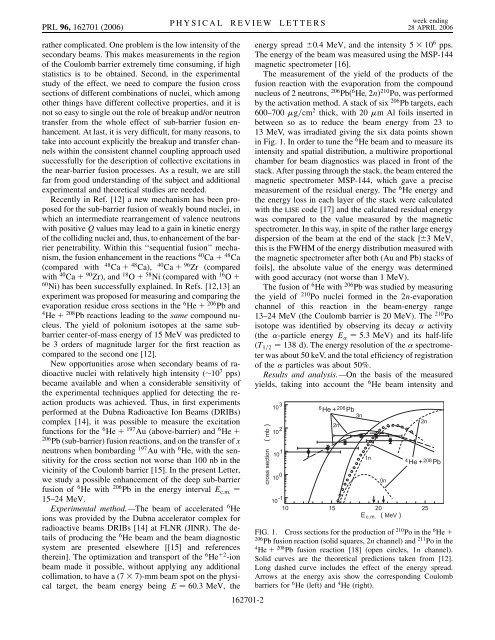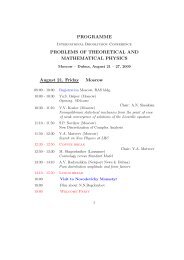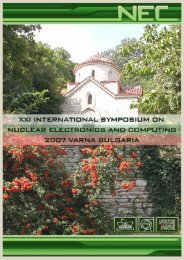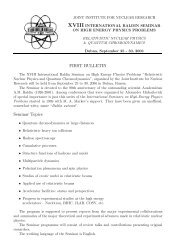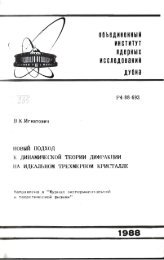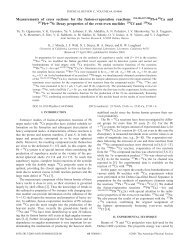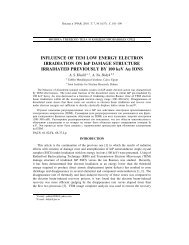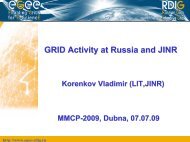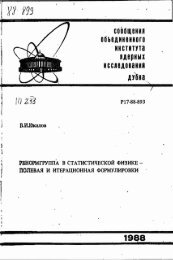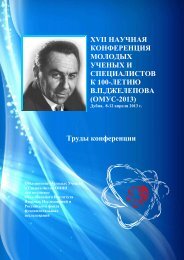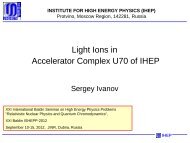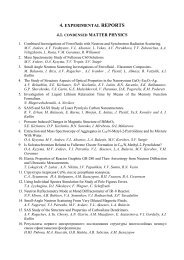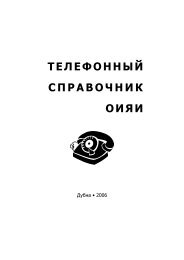View - Nrv Jinr
View - Nrv Jinr
View - Nrv Jinr
Create successful ePaper yourself
Turn your PDF publications into a flip-book with our unique Google optimized e-Paper software.
PRL 96, 162701 (2006)PHYSICAL REVIEW LETTERS week ending28 APRIL 2006rather complicated. One problem is the low intensity of thesecondary beams. This makes measurements in the regionof the Coulomb barrier extremely time consuming, if highstatistics is to be obtained. Second, in the experimentalstudy of the effect, we need to compare the fusion crosssections of different combinations of nuclei, which amongother things have different collective properties, and it isnot so easy to single out the role of breakup and/or neutrontransfer from the whole effect of sub-barrier fusion enhancement.At last, it is very difficult, for many reasons, totake into account explicitly the breakup and transfer channelswithin the consistent channel coupling approach usedsuccessfully for the description of collective excitations inthe near-barrier fusion processes. As a result, we are stillfar from good understanding of the subject and additionalexperimental and theoretical studies are needed.Recently in Ref. [12] a new mechanism has been proposedfor the sub-barrier fusion of weakly bound nuclei, inwhich an intermediate rearrangement of valence neutronswith positive Q values may lead to a gain in kinetic energyof the colliding nuclei and, thus, to enhancement of the barrierpenetrability. Within this ‘‘sequential fusion’’ mechanism,the fusion enhancement in the reactions 40 Ca48 Ca(compared with 48 Ca 48 Ca), 40 Ca 96 Zr (comparedwith 40 Ca 90 Zr), and 18 O 58 Ni (compared with 16 O60 Ni) has been successfully explained. In Refs. [12,13] anexperiment was proposed for measuring and comparing theevaporation residue cross sections in the 6 He206 Pb and4 He 208 Pb reactions leading to the same compound nucleus.The yield of polonium isotopes at the same subbarriercenter-of-mass energy of 15 MeV was predicted tobe 3 orders of magnitude larger for the first reaction ascompared to the second one [12].New opportunities arose when secondary beams of radioactivenuclei with relatively high intensity ( 10 7 pps)became available and when a considerable sensitivity ofthe experimental techniques applied for detecting the reactionproducts was achieved. Thus, in first experimentsperformed at the Dubna Radioactive Ion Beams (DRIBs)complex [14], it was possible to measure the excitationfunctions for the 6 He197 Au (above-barrier) and 6 He206 Pb (sub-barrier) fusion reactions, and on the transfer of xneutrons when bombarding 197 Au with 6 He, with the sensitivityfor the cross section not worse than 100 nb in thevicinity of the Coulomb barrier [15]. In the present Letter,we study a possible enhancement of the deep sub-barrierfusion of 6 He with 206 Pb in the energy interval E c:m:15–24 MeV.Experimental method.—The beam of accelerated 6 Heions was provided by the Dubna accelerator complex forradioactive beams DRIBs [14] at FLNR (JINR). The detailsof producing the 6 He beam and the beam diagnosticsystem are presented elsewhere [[15] and referencestherein]. The optimization and transport of the 6 He 2 -ionbeam made it possible, without applying any additionalcollimation, to have a (7 7)-mm beam spot on the physicaltarget, the beam energy being E 60:3 MeV, the162701-2energy spread 0:4 MeV, and the intensity 5 10 6 pps.The energy of the beam was measured using the MSP-144magnetic spectrometer [16].The measurement of the yield of the products of thefusion reaction with the evaporation from the compoundnucleus of 2 neutrons, 206 Pb 6 He; 2n 210 Po, was performedby the activation method. A stack of six 206 Pb targets, each600–700 g=cm 2 thick, with 20 m Al foils inserted inbetween so as to reduce the beam energy from 23 to13 MeV, was irradiated giving the six data points shownin Fig. 1. In order to tune the 6 He beam and to measure itsintensity and spatial distribution, a multiwire proportionalchamber for beam diagnostics was placed in front of thestack. After passing through the stack, the beam entered themagnetic spectrometer MSP-144, which gave a precisemeasurement of the residual energy. The 6 He energy andthe energy loss in each layer of the stack were calculatedwith the LISE code [17] and the calculated residual energywas compared to the value measured by the magneticspectrometer. In this way, in spite of the rather large energydispersion of the beam at the end of the stack [ 3 MeV,this is the FWHM of the energy distribution measured withthe magnetic spectrometer after both (Au and Pb) stacks offoils], the absolute value of the energy was determinedwith good accuracy (not worse than 1 MeV).The fusion of 6 He with 206 Pb was studied by measuringthe yield of 210 Po nuclei formed in the 2n-evaporationchannel of this reaction in the beam-energy range13–24 MeV (the Coulomb barrier is 20 MeV). The 210 Poisotope was identified by observing its decay activity(the -particle energy E 5:3 MeV) and its half-life(T 1=2 138 d). The energy resolution of the spectrometerwas about 50 keV, and the total efficiency of registrationof the particles was about 50%.Results and analysis.—On the basis of the measuredyields, taking into account the 6 He beam intensity andFIG. 1. Cross sections for the production of 210 Po in the 6 He206 Pb fusion reaction (solid squares, 2n channel) and 211 Po in the4 He 208 Pb fusion reaction [18] (open circles, 1n channel).Solid curves are the theoretical predictions taken from [12].Long dashed curve includes the effect of the energy spread.Arrows at the energy axis show the corresponding Coulombbarriers for 6 He (left) and 4 He (right).


